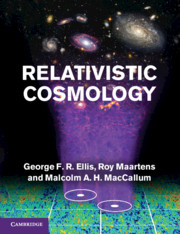Book contents
- Frontmatter
- Contents
- Preface
- Part 1 Foundations
- Part 2 Relativistic cosmological models
- Part 3 The standard model and extensions
- 9 Homogeneous FLRW universes
- 10 Perturbations of FLRW universes
- 11 The cosmic background radiation
- 12 Structure formation and gravitational lensing
- 13 Confronting the Standard Model with observations
- 14 Acceleration from dark energy or modified gravity
- 15 ‘Acceleration’ from large-scale inhomogeneity?
- 16 ‘Acceleration’ from small-scale inhomogeneity?
- Part 4 Anisotropic and inhomogeneous models
- Part 5 Broader perspectives
- Appendix: Some useful formulae
- References
- Index
13 - Confronting the Standard Model with observations
from Part 3 - The standard model and extensions
Published online by Cambridge University Press: 05 April 2012
- Frontmatter
- Contents
- Preface
- Part 1 Foundations
- Part 2 Relativistic cosmological models
- Part 3 The standard model and extensions
- 9 Homogeneous FLRW universes
- 10 Perturbations of FLRW universes
- 11 The cosmic background radiation
- 12 Structure formation and gravitational lensing
- 13 Confronting the Standard Model with observations
- 14 Acceleration from dark energy or modified gravity
- 15 ‘Acceleration’ from large-scale inhomogeneity?
- 16 ‘Acceleration’ from small-scale inhomogeneity?
- Part 4 Anisotropic and inhomogeneous models
- Part 5 Broader perspectives
- Appendix: Some useful formulae
- References
- Index
Summary
The basic observational concepts and relations in cosmology were introduced in Chapter 7. Here we consider how this works out when applied to the standard models of cosmology: how do current observations support and refine the use of perturbed FLRW models, discussed in Chapters 9 to 12? This is crucial in determining how acceptable these models are as models of the real universe: observational testing is the core of scientific cosmology.
Extraordinary progress has been made in this regard in recent decades. Multi-wavelength observations (radio to γ-ray) of vast numbers of sources and various backgrounds have been made, gathering massive amounts of data. This has been based on developments in telescopes (ground-based, balloon-borne, space-based), detectors (photomultipliers, CCDs, fibre optics, adaptive optics, interferometric spectrometers, etc.), and high-performance computing power. We cannot go into those developments here, but simply refer to Lena, Lebrun and Mignard (2010) for a survey.
An important feature of the observational constraints is that they have two separate aspects. On the one hand, we can test the background model by observations that probe the expansion history, such as the magnitude–redshift diagram, and, on the other hand, we can test perturbations about the background by observations that probe the CMB anisotropies and the growth of structure.
For the background, we use galaxies, supernovae and the CMB as markers of the geometry of the background model; for this purpose we are only interested in their capacity to provide standard candles and standard rulers.
Information
- Type
- Chapter
- Information
- Relativistic Cosmology , pp. 345 - 369Publisher: Cambridge University PressPrint publication year: 2012
